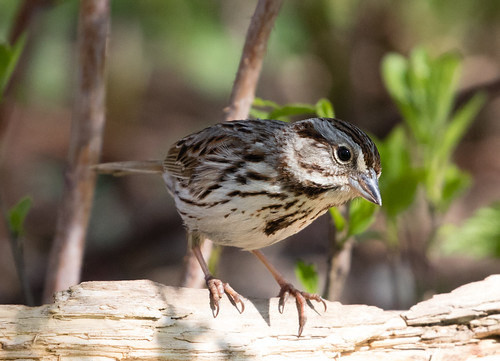 |
| Margaret Morse Nice (December 6, 1883 - June 26, 1974), American ornithologist, lying flat in grass to study nest of baby field sparrows. Photograph taken by Al Fenn, circa 1956. From Wikipedia |
On May 11, 1935, an ornithologist named Margaret Morse Nice went outside and tracked one particular male Song Sparrow bearing a color band for an entire 24 hours. The bird, nicknamed 4M, spent roughly 10 hours singing, 9 hours roosting, and 5 hours eating and doing other miscellaneous Song Sparrow activities. During the song bouts that added up to 10 hours, he sang 2,305 complete songs.
Margaret Morse Nice had earned her B.A. from Mount Holyoke College in 1906. She and her husband, a professor of physiology at Harvard medical school, married in 1908 while she was working on her M.A. in biology at Clark University in Worcester, Massachusetts. In 1910, her husband took a job in Norman, Oklahoma, and they started their family, five children born between 1911 and 1922. She finished her M.A. in child development, using her children as subjects for her thesis, “Development of a Child's Vocabulary in Relation to Environment.” She published 18 research papers about language development in children, mostly between 1915 and 1922.
Margaret Morse Nice had always been interested in birds, too. She’d published a paper about the diet of the Northern Bobwhite back in 1910, and in Oklahoma, she started conducting research on Mourning Doves and updated the huge tome, The Birds of Oklahoma. She studied and recorded hierarchies in chickens three decades before the Norwegian zoologist who coined the term “pecking order.”
Her husband took a job at Ohio State University in 1927, where she started doing the work she is most famous for, on Song Sparrows. She was also the first person to notice that a whole lot of the basic information about birds published in books and even scientific journals had never been verified by anybody in the real world. Indeed, when she started tracking them down, some of the incubation periods listed for American songbirds came originally from Aristotle!
Over her lifetime, she wrote nearly 250 papers about birds, 3,000 book reviews, and books such as The Watcher at the Nest, Research Is a Passion with Me, and the two-volume Studies in the Life History of the Song Sparrow. In the bibliography of the very first ornithology textbook I used, by Welty, copyrighted in 1975, eleven of her works are cited. And much more recent ornithology textbooks still cite her work on Song Sparrows and also a paper she wrote for the Linnaean Society, “Development of behavior in precocial birds,” published in 1962.
Margaret Morse Nice was made an honorary member of the British, Finnish, German, Dutch, and Swiss ornithological societies. She received the AOU's Brewster Medal in 1942 for her studies of the Song Sparrow, becoming only the second woman to receive it. She received two honorary Doctorates. A Mexican subspecies of song sparrow is named after her. And in 1997 the Wilson Ornithological Society established the Margaret Morse Nice Medal for work in ornithology. She died at the age of 90 in 1974.
I first heard about her in the two ornithology courses I took at Michigan State University in 1975 and 1976. In both classes, the professors described her as a “bored housewife” who studied Song Sparrows in her backyard. She may not have had a paid job in ornithology, but she set standards for field studies that few ornithologists before or after her, including those ornithology professors, could match.
I thought about this a few years ago when I leading a field trip with a prominent ornithologist and another woman who had done seminal work came up. We pointed out a Red-eyed Vireo singing away, and I said that one male sang 22,197 songs in a single day. He added that they were counted by a woman who had nothing better to do with her time. He couldn’t remember her name, so I interjected that she was Louise de Kiriline Lawrence, who also happened to be the person who wrote more informational pamphlets and articles for Audubon than anyone ever.
Back in the 1700s and 1800s, a great many men became well-known ornithologists who did not have jobs at universities or museums—they simply studied birds as part of their daily lives. Army doctors in particular became prominent bird researchers. A handful of women quietly went about their work and managed to get published in prestigious journals, yet even today they are somehow dismissed as “housewives,” despite the seminal work they did, of a higher level than anything the modern men dismissing them as hobbyists ever accomplished in their so-called professional careers.
I thought about Margaret Morse Nice this year on Mother’s Day, and today, as I write this on the 85th anniversary of her going out and following one Song Sparrow not just from sun up to sun down, but from midnight to midnight. My own backyard Song Sparrows are singing up a storm right now. I don’t need to go out and count their songs one by one—that’s already been done, by Margaret Morse Nice. Here’s to her.


